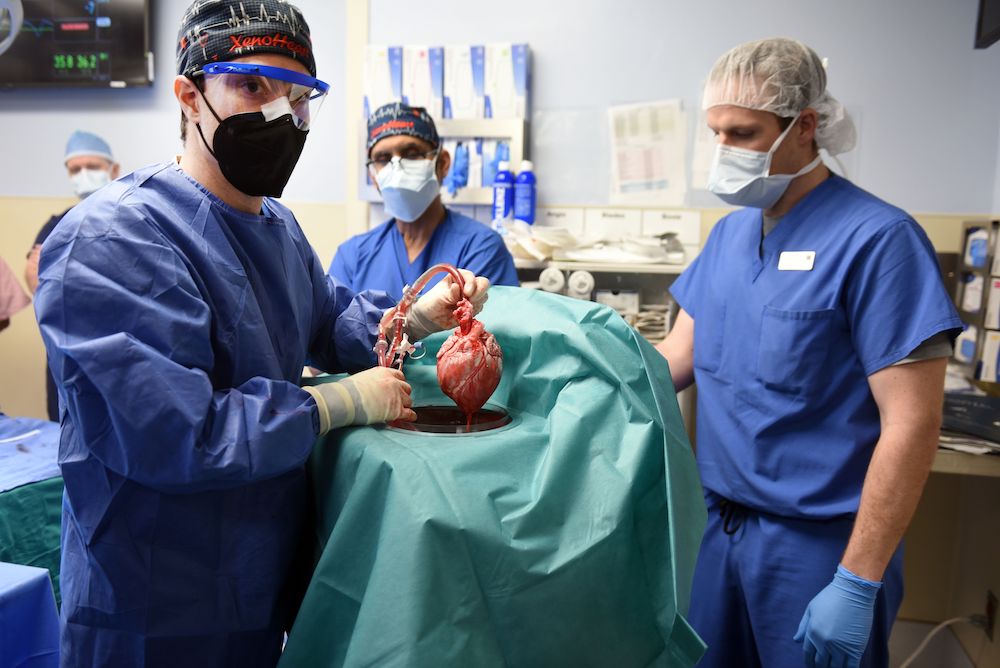Create a free profile to get unlimited access to exclusive videos, sweepstakes, and more!
That's all folks! The first-ever pig to human heart transplant completed
A pig heart is pumping blood through the body of a 57-year-old Maryland man.

The demand for transplantable organs grossly outweighs the supply of suitable organs. Currently, there are more than 100,000 people on the organ transplant list and roughly a third of them will receive new organs this year, if current trends continue. Each day, approximately ten people die waiting for life-saving organs which will never come.
The remainder will stay on the wait list, hoping to find a suitable organ before time runs out. Scientists, in an attempt to bridge the gap between waiting patients and life-saving organs, are looking toward evolutionarily similar animals for potential solutions.
Pigs, more than even closely related primates, offer an avenue for usable organs. Primates were originally chosen as a source of animal organs, but those efforts have ceased owing to the potential spread of disease and ethical concerns surrounding their medical use.
Pigs, however, are not only widely bread for agricultural uses, but they also have organs which are genetically and structurally similar to ours. One major hurdle in the use of porcine organs is the production of a particular protein which causes rapid rejection inside human bodies.
In order to overcome the problem of rejection, companies like Revivicor are genetically modifying pigs such that their organs no longer contain that protein. Similar strategies have resulted in the production of porcine kidneys compatible with human bodies, and the first successful animal to human transplant was completed only late last year.
The previous operation was completed on a patient who was essentially deceased. The body was maintained for 54 hours after the surgery in order to provide a proof of concept for xenotransplantation which might later be used in life-saving scenarios. That surgery showed that the genetic modification of porcine tissues could remove the risk of immediate rejection. Still, transplanting pig organs into living human patients was thought to remain in the future, as more study was needed before we were ready for human trials. That is until a pressing medical scenario presented itself over the last several weeks.
No one thought such a situation would arise this quickly, but circumstances arose at the University of Maryland Medical Center which necessitated quick action. While xenotransplantation is not currently approved by the U.S. Food and Drug Administration (FDA), they provided emergency authorization for the surgery as an experimental last resort.
David Bennett, a 57-year-old resident of Maryland, was in need of a new heart but wasn’t eligible for an organ through traditional means. Bennett was experiencing a life-threatening arrythmia and was connected to a heart-lung bypass machine. Bennett’s medical options were limited, but without intervention there was considerable risk that he would die.
Before the surgery, Bennett was informed of the risks and agreed to undergo the experimental surgery, noting that the risks were worth the possibility of recovery. “It was either die or do this transplant. I want to live. I know it’s a shot in the dark, but it’s my last choice,” Bennett said, according to a statement from the University of Maryland Medical Center.
These sorts of genetically modified animal organs are the result of decades of research looking for alternative sources of organ tissues compatible with human bodies. If successful, porcine organs could fill the gap in needed organ transplants for tens of thousands of waiting patients.
At current, there is no indication of a negative response as a result of the pig heart pumping blood throughout Bennett's body. It’s been three days since the surgery and there are no signs of immediate rejection, proving that animal organs can operate similarly to human organs at least in the short term. Of course, the patient will remain under observation in the coming days, weeks, and months, to ensure there are no other complications, but initial signs are good.
If all goes according to plan, Bennett should recover smoothly and go down in history as the first in a long line of post-operatively healthy patients afforded additional time and renewed health through the ingenuity of scientists and the sacrifice of our porcine friends.


























